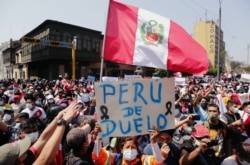Peru's political crisis appeared on the verge of resolution Monday as Congress cleared the way for an elder statesman and consensus candidate to become the country's third president in a week.
Jubilant people waved the nation's red-and-white flag and blared horns on the streets of Peru's capital as Francisco Sagasti of the centrist Purple Party was selected as the new president of Congress.
The 76-year-old engineer has not yet been sworn into office, but as head of Congress he becomes the nation's chief of state by default. Peru currently has no president or vice president, making him next in line.
It will now fall on Sagasti to heal a nation bruised by a week of upheaval.
"What's at stake is taking a first step toward rebuilding confidence between the people and the state," said Samuel Rotta, president of the Peruvian chapter of Transparency International.
Applause erupted in the legislative palace as Sagasti clinched the required majority vote. A respected academic, he has also spent decades consulting government institutions and held a post at the World Bank. Shortly after the vote, he took an oath to become Congress' president.
"We will do everything possible to return hope to the people and show them they can trust in us," he said in his first remarks.
Many in the Latin American nation are hopeful Sagasti's appointment will mark the end of a tumultuous week in which thousands took to the streets outraged by Congress' decision to oust popular ex-President Martín Vizcarra. During the upheaval, two young men died and dozens were injured. Peru also spent more than 24 hours with no designated chief of state.
Sagasti could steer the country back toward stability because he is in a position to win the support of both Congress and demonstrators. He and his Purple Party bloc were among 19 of 130 lawmakers to vote against Vizcarra's removal. That will earn him credibility among protesters who condemned the ouster as a power grab. Unlike Vizcarra, he also has a party in Congress representing him.
"Sagasti is someone who inspired confidence among a lot of people," said Jo-Marie Burt, a senior fellow with the Washington Office on Latin America. "He's an accidental president — but I wouldn't say he's someone without a plan."
Peru has much on the line: The country is in the throes of one of the world's most lethal coronavirus outbreaks, and political analysts say the constitutional crisis cast the country's democracy into jeopardy.
Deadly protests
The protests that rocked Peru were unlike any seen in recent years, fueled largely by young people typically apathetic to the country's notoriously erratic politics. They came a year after a wave of anti-government demonstrations around Latin America demanding better conditions for the poor and working class.
Human rights groups accused police of mounting an excessive response to the protests, lashing out at demonstrators with batons, rubber bullets and tear gas. The two protesters who died suffered multiple wounds — Jack Pintado, 22, was shot 11 times, including in the head, and Jordan Sotelo, 24, was hit four times in the chest near his heart, according to authorities.
"People on the streets, in their homes, on their balconies and on social media are very, very upset," Rotta said. "Peru is a country with high levels of mistrust. Politicians profoundly aggravated that."
Widespread corruption
At the crux of the unrest are long-simmering tensions over corruption in Peru. Every living former president has been accused or charged — most in the massive Odebrecht graft scandal in which the Brazilian construction giant admitted to doling out millions to politicians in exchange for lucrative public works contracts. Meanwhile, half of Congress is also under investigation for crimes ranging from money laundering to homicide.
Vizcarra attracted legions of supporters for his efforts to change that. He dissolved Congress last year, reformed how judges are chosen and tried to get rid of the prosecutorial immunity granted to lawmakers. But he had no party backing him in Congress and sparred with legislators constantly.
Lawmakers ousted him using a 19th-century-era clause claiming he showed "permanent moral incapacity." They accused him of taking more than $630,000 in bribes in exchange for two construction contracts while governor of a small province years ago. Prosecutors are investigating the accusations, but Vizcarra has not been charged. He vehemently denies any wrongdoing.
The country's highest court is currently evaluating whether Congress broke the law in removing him from office — a decision that experts said would not be retroactive but could have implications going forward. Some analysts said the ordeal shows Peru's political system needs reform so that no one branch of government has outsized power.
After Vizcarra was removed, then-Congress president Manuel Merino became president. The little-known politician and rice farmer faced daily protests. He promised to keep in place a scheduled presidential election in April. But his conservative Cabinet appointments irked many. He resigned Sunday, just five days after being sworn into office.










